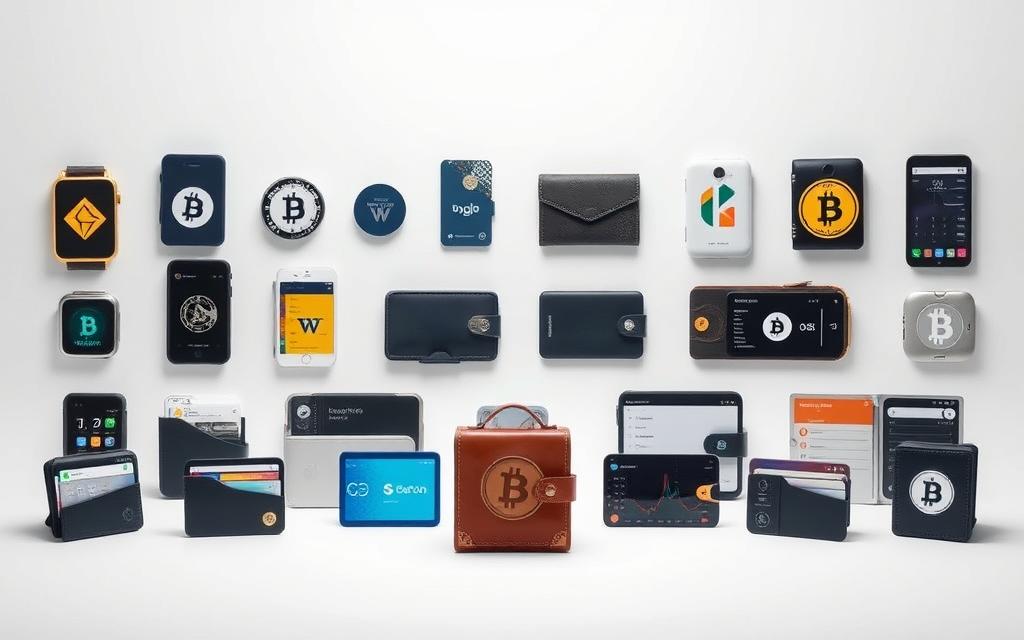A cryptocurrency wallet is a digital tool for storing, sending, and receiving cryptocurrencies. It’s vital for anyone investing in digital currency. With so many options, picking the right one can be tough. Knowing the basics of crypto wallets helps make a smart choice.
Crypto wallets offer a safe way to manage digital currency. They come in different types, like hot and cold wallets. Investors can pick from various wallets, such as Coinbase Wallet, MetaMask, and Ledger. These wallets support many blockchains and have advanced security features.
When choosing a wallet, think about security, ease of use, and cost. Also, consider the type of digital currency you want to store. Ledger supports over 5,000 cryptocurrencies, while Trezor supports over 1,000.
Crypto wallets are designed for secure and easy management of digital assets. As digital currency grows in popularity, so does the need for safe wallets. Investors look for wallets with features like two-factor authentication and multi-signature support. By understanding the different types of wallets, investors can pick the best one for their needs.
Understanding Cryptocurrency Wallets: The Basics
Cryptocurrency wallets are key for managing digital currencies. They use public and private keys for transactions on the blockchain. Keeping these keys safe is vital to protect your assets.
Wallets come in two main types: hot and cold. Hot wallets are online and riskier, while cold wallets are offline and safer. Your choice depends on what you value more: convenience or security.
When picking a wallet, look for security features like encryption and two-factor authentication. Also, consider backup and recovery options. Knowing about non-custodial and custodial wallets helps you make a better choice. This way, you can protect your digital assets effectively.
Here is a summary of the key points to consider when choosing a wallet:
- Security features: encryption, two-factor authentication, backup and recovery options
- Wallet types: hot wallets, cold wallets, non-custodial wallets, custodial wallets
- Blockchain: transactions are facilitated on the blockchain, which is a decentralized and secure network
| Wallet Type | Security Features | Convenience |
|---|---|---|
| Hot Wallets | Encryption, two-factor authentication | High |
| Cold Wallets | Offline storage, encryption | Low |
How Many Cryptocurrency Wallets Are There?
The number of cryptocurrency wallets has grown a lot with digital currency’s rise. There are many crypto wallets to pick from, each with special features and security. Over 10,000 cryptocurrencies are out there, and many wallets handle a wide variety of digital assets.
Popular wallets like MetaMask and Ledger support thousands of digital assets. Trust Wallet claims to handle over 10 million digital assets and more than 100 blockchains. With so many options, it’s important to know the different types and their features to keep your digital currency safe.
Here are some key statistics about cryptocurrency wallets:
- Approximately 46 million Bitcoin wallets hold at least $1 of value.
- Over 460 million Bitcoin wallets have been created, with around 90% being inactive or holding minimal value.
- Only 21.5 million wallets hold more than $100.
When picking a cryptocurrency wallet, think about security, ease of use, and the assets it supports. Choosing the right wallet ensures a safe and easy crypto experience.
Hot Wallets vs Cold Wallets: The Primary Categories
Users have two main choices for storing cryptocurrency: hot wallets and cold wallets. The key difference is their internet connection. Hot wallets are online, making them riskier. Cold wallets stay offline, offering better security. For more on the differences, check out hot wallet vs cold wallet guides.
Hot wallets are good for small amounts of crypto for daily use. They keep private keys on devices connected to the internet. Cold wallets, or offline storage, don’t connect to the internet. This makes them safer for long-term crypto storage. Security features are key when picking between hot and cold wallets.
- Hot wallets: easy for daily transactions, but riskier for security
- Cold wallets: safer, but less handy for daily use
When it comes to security features, cold wallets are safer than hot wallets. They’re not online, so they’re less at risk of hacking. Yet, each wallet has its own pros and cons. The right choice depends on what you need and prefer.
Different Types of Hot Wallets
Hot wallets are always online, making them more at risk of hacks and theft. They include software wallets and hardware wallets, each with unique features and security steps.
Popular hot wallets are MetaMask, Coinbase Wallet, and Edge Wallet. They serve different crypto ecosystems. These wallets are free but might charge for some transactions. It’s wise to keep only a small amount of crypto in a hot wallet to reduce theft risks.
Choosing the right hot wallet is key. Software wallets are great for newbies, while hardware wallets are best for seasoned investors. Knowing the different hot wallets helps you pick the best one for your needs, ensuring a safe and easy crypto journey.
- Always connected to the internet
- More vulnerable to hacks and theft
- Various types, including software and hardware wallets
- Often free to download and use
- May charge fees for certain transactions
| Wallet Type | Features | Security Measures |
|---|---|---|
| Software Wallets | Easy to use, accessible on multiple devices | Password protection, two-factor authentication |
| Hardware Wallets | Offline storage, physical security | Private key protection, PIN code |
Hardware Wallets: The Cold Storage Solution
Hardware wallets are a type of cold storage. They offer extra security for your digital currency. Since they’re not connected to the internet, they’re very secure. Users have full control over their private keys.
Well-known brands like Ledger, Trezor, and Cypherock make these wallets. They support many digital assets. Ledger works with over 5,550 assets, and Trezor with over 8,000. Setting one up involves setting a PIN and writing down a seed phrase.
Hardware wallets give you more control over your private keys. They’re safer than hot wallets or exchanges. You can manage your keys securely. The user interface is often through a companion app. Prices range from $69 to $398.
Look for security features like non-custodial storage and offline signing. They also protect against cyber-attacks like phishing and keylogging. Here’s a comparison of some popular hardware wallets:
| Wallet | Supported Assets | Price |
|---|---|---|
| Ledger Nano X | Over 5,550 | $149 |
| Trezor Model T | Over 8,000 | $170 |
| Cypherock X1 | Over 8,000 | $299 |
By picking a reputable hardware wallet, you can have a safe and easy crypto journey.
Mobile vs Desktop vs Web-Based Wallets
Users have many wallet options for managing cryptocurrencies, like mobile, desktop, and web-based wallets. Each has special features and security levels. Mobile wallets are great for quick transactions on the move. They let users pay and move funds from their phones.
Desktop wallets are best for keeping funds safe over time. They offer a secure spot for managing cryptocurrencies.
Web-based wallets are easy to use but might not be as safe. To stay safe, users should use strong passwords and two-factor authentication. Wallets like Apple Pay and Google Pay already have these security steps.
Here are some main differences between these wallets:
- Mobile wallets: portable, easy to use, and perfect for quick transactions
- Desktop wallets: more secure, great for long-term storage, and need a PIN and recovery phrase
- Web-based wallets: easy to access, but might be riskier for hacking and theft
The right wallet choice depends on what you need. Knowing the differences helps users pick wisely. This ensures a safe and easy crypto experience.
Security Considerations for Your Digital Assets
Security is key when it comes to cryptocurrency wallets. With more digital assets around, the chance of theft has gone up. It’s known that 17% to 23% of Bitcoin has been lost because of lost private keys. In 2017, 13.7% of the world’s population said they had been hacked, including their digital assets.
To keep your digital assets safe, you need to know about common threats and how to protect them. Use strong passwords and two-factor authentication. Hot wallets are more at risk because they’re online, but cold wallets are safer since they’re offline.
Common Security Threats
- Hacks and phishing attacks
- Lost or stolen private keys
- Malware and virus attacks
It’s also important to have a plan for backup and recovery in case of trouble. Back up your wallet regularly and keep your private keys in a safe place.
Best Practices for Wallet Protection
To reduce the risk of losing your digital assets, follow these best practices. Use both hot and cold wallets. Spread your assets across different wallets. And use separate wallets for different things.
Choosing the Right Wallet for Your Needs
Choosing a wallet involves looking at wallet types, user profiles, and cost considerations. It’s key to understand these to pick the right wallet for you. This ensures your crypto is safe and meets your needs.
There are Kronos and non-Kronos wallets, but in crypto, we mainly see custodial and non-custodial wallets. Your choice affects how safe your assets are and how much control you have.
Factors to Consider When Selecting a Wallet
When picking a wallet, think about security, ease of use, and compatibility with many cryptocurrencies. Hardware wallets cost between $50 and $200. Software wallets can be free or have different levels of features.
Matching Wallet Types to User Profiles
Each wallet type suits different user profiles. Beginners might like custodial wallets for their simplicity. More experienced users might choose non-custodial wallets for better security and control. Cost considerations are also important, as some wallets have extra features for a higher price.
Cost Considerations and Features
When looking at cost considerations, think about the features each wallet offers. Some wallets have advanced security like 2-Factor Authentication (2FA). Others have easier-to-use interfaces. By comparing, you can find a wallet that fits your needs and budget.
Conclusion: Securing Your Crypto Journey with the Perfect Wallet
Starting your journey with cryptocurrency means choosing the right wallet is key. There are many cryptocurrency wallets out there. It’s important to know the difference between hot wallets and cold wallets to keep your digital assets safe.
Hot wallets are easy to use but riskier online. Cold wallets are safer but can be harder to use. Think about what you need before making a choice.
When picking a wallet, look at security, how well it works with different currencies, how easy it is to use, and the cost. Choose wallets with strong security like two-factor authentication and open-source code. Make sure the wallet works with the cryptocurrencies you want to use.
Think about your skill level and the wallet’s user experience. Compare the cost of hardware wallets to the fees of software wallets. This will help you decide.
The success of your crypto journey depends on understanding each wallet type’s strengths and weaknesses. Make a choice that fits your needs and preferences. By doing your research and picking the right digital currency wallet, you can protect your investments and move through the changing crypto world with confidence.
FAQ
What is a cryptocurrency wallet?
A cryptocurrency wallet is a digital place to keep, send, and get digital money like Bitcoin and Ethereum. It’s like a safe for your digital money.
How do cryptocurrency wallets work?
Wallets use special keys to manage your digital money. The public key is for getting money, and the private key is for controlling it.
What are the different types of cryptocurrency wallets?
There are many types of wallets, like hot wallets (online) and cold wallets (offline). Each has its own good points and downsides, depending on what you need and how safe you want it to be.
What is the difference between hot and cold wallets?
Hot wallets are online and good for quick transactions. Cold wallets are offline and safer for keeping money long-term.
What are the different types of hot wallets?
Hot wallets include software, mobile, and web-based wallets. They vary in how easy they are to use, how safe they are, and who they’re best for.
What are the benefits of using a hardware wallet?
Hardware wallets add extra security for your digital money. They’re very safe for keeping money for a long time because they’re not online and can’t be hacked easily.
What are the key factors to consider when choosing a cryptocurrency wallet?
When picking a wallet, think about its security, how easy it is to use, if it fits your needs, and the cost. It’s also key to choose a wallet that matches your needs for a safe and easy experience.
What are the common security threats for cryptocurrency wallets?
Wallets can face threats like hacking, phishing, malware, and theft. To keep your money safe, use strong passwords, enable two-factor authentication, and back up your wallet regularly.




















